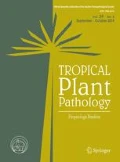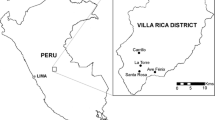Abstract
Arabica coffee (Coffea arabica L.) is a native from Africa, particularly from Ethiopia. Previously of little concern to Ethiopian farmers, coffee leaf rust (CLR), caused by the fungus Hemileia vastatrix, is an emergent disease globally. To update the status of CLR, a large survey was conducted in 405 coffee fields across nine production zones of Oromia and Southern Nations Nationalities and Peoples (SNNP) regions. The disease, evaluated one time during the month of the peak for CLR intensity for each region, was present in every single field; mean incidence and severity ranged from 5 to 86.7% (mean = 35.3%) and 0.22 to 55.5 (mean = 9.09), respectively. A complimentary log-log model was developed to predict mean field severity from mean field incidence. Altitude, a known surrogate variable for temperature, was the main driver of the epidemics. Incidence and severity were highest at the lowland fields, where poorly managed plantations of local varieties grown under open sun were also more dominant. CLR intensity decreased with the increase in altitude at the highlands where well-managed and improved varieties grown under the shade in forest systems dominate the scenario. Our results contribute to increase awareness of a growing problem threatening coffee fields that are still under lower risk, such as at the highlands, particularly if temperatures rise and farmers cut forest to grow plantations of susceptible cultivars. Improving genetic resistance and adoption of best management practices are urgent to prevent the rapid surge of new races and mitigate crop losses currently overlooked by coffee farmers at the lowlands.





Similar content being viewed by others
References
Alemayehu T, Esayas K, Kassu K (2008) Coffee development and marketing improvement plan in Ethiopia. In: Girma A, Bayetta B, Tesfaye S, Endale T, Taye K (eds) Coffee diversity and knowledge. EIAR, Addis Ababa, Ethiopia, pp 375–381
Avelino J, Willocquet L, Savary S (2004) Effects of crop management patterns on coffee rust epidemics. Plant Pathology 53:541–547
Avelino J, Zelaya H, Merlo A, Pineda A, Ordon M, Savary S (2006) The intensity of a coffee rust epidemic is dependent on production situations. Ecological Modeling 197:431–447
Avelino J, Cristancho M, Georgiou S, Imbach P, Aguilar L, Bornemann G, Läderach P, Anzueto F, Hruska AJ, Morales C (2015) The coffee rust crises in Colombia and Central America (2008–2013): Impacts, plausible causes and proposed solutions. Food Security 7:303–321
Bates D, Maechler M, Bolker B, Walker S (2015) Fitting linear mixed-effects models using lme4. Journal of Statistical Software 67:1–48
Bebber DP, Castillo AD, Gurr SJ (2016) Modelling coffee leaf rust risk in Colombia with climate reanalysis data. Philosophical Transactions of the Royal Society B: Biological Sciences 371(1709):20150458
Belachew K, Teferi D, Gidisa G (2015) Screening of some Coffee arabica genotypes against coffee wilt diseases (Gibberella xylarioides Heim and Saccas) at Jimma, Southwest Ethiopia. International Journal of Sustainable Agricultural Research 2:66–76
Bigirimana J, Njoroge K, Gahakwa D, Phiri NA (2012) Incidence and severity of coffee leaf rust and other coffee pests and diseases in Rwanda. African Journal of Agricultural Research 7:3847–3852
Bock KR (1962) Seasonal periodicity of coffee leaf rust and factors affecting the severity of outbreak in Kenya Colony. Transaction of British Mycological Society 5:289–300
Brown JS, Kenny MK, Whan JH, Marrian PR (1995) The effect of temperature on the development of epidemics of coffee leaf rust in Papua New Guinea. Crop Protection 14:671–676
Bock CH, Chiang K, Del Ponte EM (2016) Accuracy of plant specimen disease severity estimates: concepts, history, methods, ramifications and challenges for the future. CAB Reviews. 11:1–21
Cerda R, Allinne C, Gary C, Philippe T, Harvey CA, Krolczyk L, Mathiot C, Clément E, Aubertot J-N, Avelino J (2016) Effects of shade, altitude and management on multiple ecosystem services in coffee agroecosystems. European Journal of Agronomy 82:308–319
CSA (2018) Central statistics authority of Ethiopia, key findings of the 2017/2018 agricultural sample surveys, Available from: http://www.csa.gov.et/ Accessed 28 July 2019
Daba G, Helsen K, Berecha G, Lievens B, Debela A, Honnay O (2018) Seasonal and altitudinal differences in coffee leaf rust epidemics on coffee berry disease-resistant varieties in Southwest Ethiopia. Tropical Plant Pathology 44:244–250
DaMatta FM (2004) Eco-physiological constraints on the production of shaded and unshaded coffee: a review. Field Crops Research 86:99–114
Davis AP, Gole TW, Baena S, Moat J (2012) The impact of climate change on indigenous arabica coffee (Coffea arabica): predicting future trends and identifying priorities. PLoS One 7:47981
Derso E, Gebrezgi T, Adugna G (2000) Significance of minor coffee diseases of Coffea arabica L. in Ethiopia: a review. In: Proceedings of the workshop on control of coffee berry disease in Ethiopia; 13–15 August 1999. Ethiopia; Addis Ababa, pp 58–64
Ehrenbergerová L, Kučera A, Cienciala E, Trochta J, Volařík D (2017) Identifying key factors affecting coffee leaf rust incidence in agroforestry plantations in Peru. Agroforestry Systems 92:1551–1565
Gandrud C (2016) Reproducible research with R and R studio. Chapman and Hall/CRC, Boca Raton, FL
Garedew W, Lamesa F, Fabrice P (2019) Landscape context and plot features influence the epidemics of coffee leaf rust (Hemileia vastatrix) in southwest Ethiopia. Archives of Phyto-Pathology and Plant Protection 52:71–89
Gentleman R, Temple Lang D (2007) Statistical analyses and reproducible research. Journal of Computation and Graphical Statistics 16:1–23
Hindorf H, Omondi CO (2011) A review of three major fungal diseases of Coffea arabica L. in the rainforests of Ethiopia and progress in breeding for resistance in Kenya. Journal of Advanced Research 2:109–120
ICO (2018) International Coffee Organization annual report 2017/2018, World coffee production report, Available from: http://www.ico.org/
Jefuka C, Fininsa C, Adugna G, Hindorf H (2010) Coffee leaf rust epidemics (Hemileia vastatrix) in montane coffee (Coffea arabica L.) forests in southwestern Ethiopia. East African Journal of Science 4:86–95
Kushalappa AC (1989) Coffee leaf rust biology and epidemiology. In: Kushalappa AC, Eskes AB (eds) Coffee rust: epidemiology, resistance and management. CRC Press Inc., Florida, pp 13–80
Kushalappa AC, Chaves GM (1980) An analysis of development of coffee rust in the field. Fitopatologia Brasileira 5:95–l03
Liebig T, Ribeyre F, Läderach P, Poehling HM, van Asten P, Avelino J (2019) Interactive effects of altitude, microclimate and shading system on coffee leaf rust. Journal of Plant Interactions 14:407–415
Lopez-Bravo DF, Virginio-Filho Ede M, Avelino J (2012) Shade is conducive to coffee rust as compared to full sun exposure under standardized fruit load conditions. Crop Protection 38:21–29
McCook S (2006) Global rust belt: Hemileia vastatrix and the ecological integration of world coffee production since 1850. Journal of Global History 1:177–195
Madden LV, Hughes G, Van Den Bosch F (2007) The study of plant disease epidemics. APS Press, St. Paul, NN
Muller RA, Berry D, Avelino J, Biesse D (2004) Coffee disease. In: Wintgens J (ed) Coffee growing, processing, sustainable production: a guidebook for growers, processors and producers. WILEY-VCH Verlag GmbH & Co. KGaA.
NMA (2018) National Meteorological Agency Climatological Services Team Annual Climate Bulletin, Addis Ababa, Ethiopia, Available from: https://www.ethiomet.gov.et/
Otiniano AJ, Ventura RB, Huamán LA, Vera NJ, Cepero VC, Amez SB (2019) Relación entre la incidencia y la severidad de la roya del café (Hemileia vastatrix) en San Ramón, Chanchamayo, Perú. Journal of Science and Research: Revista Ciencia e Investigación 4:1–9
Paul PA, El-Allaf SM, Lipps PE, Madden LV (2005) Relationships between incidence and severity of Fusarium head blight on winter wheat in Ohio. Phytopathology 95:1049–1060
Savary S, Madden LV, Zadoks JC, Klein-Gebbinck HW (1995) Use of categorical information and correspondence analysis in plant disease epidemiology. Advances in Botanical Research 21:213–240
Seem RC (1984) Disease incidence and severity relationships. Annual Review of Phytopathology 22:133–150
Silva-Acuña R, Maffia LA, Zambolim L, Berger RD (1999) Incidence-severity relationships in the pathosystem Coffea arabica–Hemileia vastatrix. Plant Disease 83:186–188
Spolti P, Shah DA, Fernandes JM, Bergstrom GC, Del Ponte EM (2015) Disease risk, spatial patterns, and incidence-severity relationships of Fusarium head blight in no-till spring wheat following maize or soybean. Plant Disease 99:1360–1366
Sylvain PG (1958) Some observations on Coffea arabica L. in Ethiopia. Turrialba 5:37–54
Talhinhas P, Batista D, Diniz I, Vieira A, Silva DN, Loureiro A, Tavares S, Pereira AP, Azinheira HG, Guerra-Guimarães L, Várzea V (2017) The coffee leaf rust pathogen Hemileia vastatrix one and a half centuries around the tropics. Molecular Plant Pathology 18:1039–1051
Teferi D, Belachew K (2018) A review of coffee diseases research in Ethiopia. International Journal of Agriculture and Bioscience 7:65–70
USDA (2018) United States Department of Agriculture, Ethiopian coffee annual report. Foreign agricultural service, global agricultural information network, available: http://www.fas.usda.gov/
WCR (2018) World coffee research annual report. Available at: https://worldcoffeeresearch.org/
Wickham H, Averick M, Bryan J, Chang W, McGowan LD, François R, Grolemund G, Hayes A, Henry L, Hester J, Kuhn M, Pedersen TL, Miller E, Bache SM, Müller K, Ooms J, Robinson D, Seidel DP, Spinu V, Takahashi K, Vaughan D, Wilke C, Woo K, Yutani H (2019) Welcome to the tidyverse. Journal of Open Source Software 4:1686
Willocquet L, Savary S (2004) Effects of crop management pattern on coffee rust epidemics. Plant Pathology 53:541–547
Wondimu M (1991) Epidemiology and resistance of coffee leaf rust in Ethiopia. Ministry of Coffee and Tea Development, Addis Ababa, Ethiopia
Workafes W, Kassu K (2000) Coffee production systems in Ethiopia. In: Proceedings of the workshop on control of coffee berry disease in Ethiopia, 13-15 August 1999, Addis Ababa, pp 99–107
Xie Y, Allaire JJ, Grolemund G (2018) R markdown: the definitive guide. Chapman and Hall/CRC, Boca Raton, FL
Zambolim L (2016) Current status and management of coffee leaf rust in Brazil. Tropical Plant Pathology 41:1–8
Acknowledgments
This work represents part of a research project to be submitted to Jimma University College of Agriculture and Veterinary Medicine of Jimma University by K.B. Bekele as a requirement for him to be awarded a PhD in Horticulture. The authors would like to express their gratitude to Ethiopian Institute of Agricultural Research and Jimma University for Financial and logistics support to this research work. K.B.B. also thanks the World Coffee Research for providing funding for his split-PhD training period in the Departamento de Fitopatologia at the Universidade Federal de Viçosa (Brazil). Moreover, we want to thank the staffs of Jimma Agricultural Research Center department of Plant Pathology Research, particularly Mr. Mamo Abiye, Mr. Nagasa Dachasa, and Mr. Legese Hagos for their unreserved support during the survey and data collection.
Author information
Authors and Affiliations
Contributions
KBB, GA, and WG designed the study. KB collected the data and wrote the manuscript. EMD performed the statistical analyses, interpreted the data, and wrote the manuscript. RWB wrote the manuscript. All authors read the manuscript and gave final approval for publication.
Corresponding author
Additional information
Publisher’s note
Springer Nature remains neutral with regard to jurisdictional claims in published maps and institutional affiliations.
Electronic supplementary material
ESM 1
(DOCX 460 kb)
Rights and permissions
About this article
Cite this article
Belachew, K., Senbeta, G.A., Garedew, W. et al. Altitude is the main driver of coffee leaf rust epidemics: a large-scale survey in Ethiopia. Trop. plant pathol. 45, 511–521 (2020). https://doi.org/10.1007/s40858-020-00383-4
Received:
Accepted:
Published:
Issue Date:
DOI: https://doi.org/10.1007/s40858-020-00383-4




